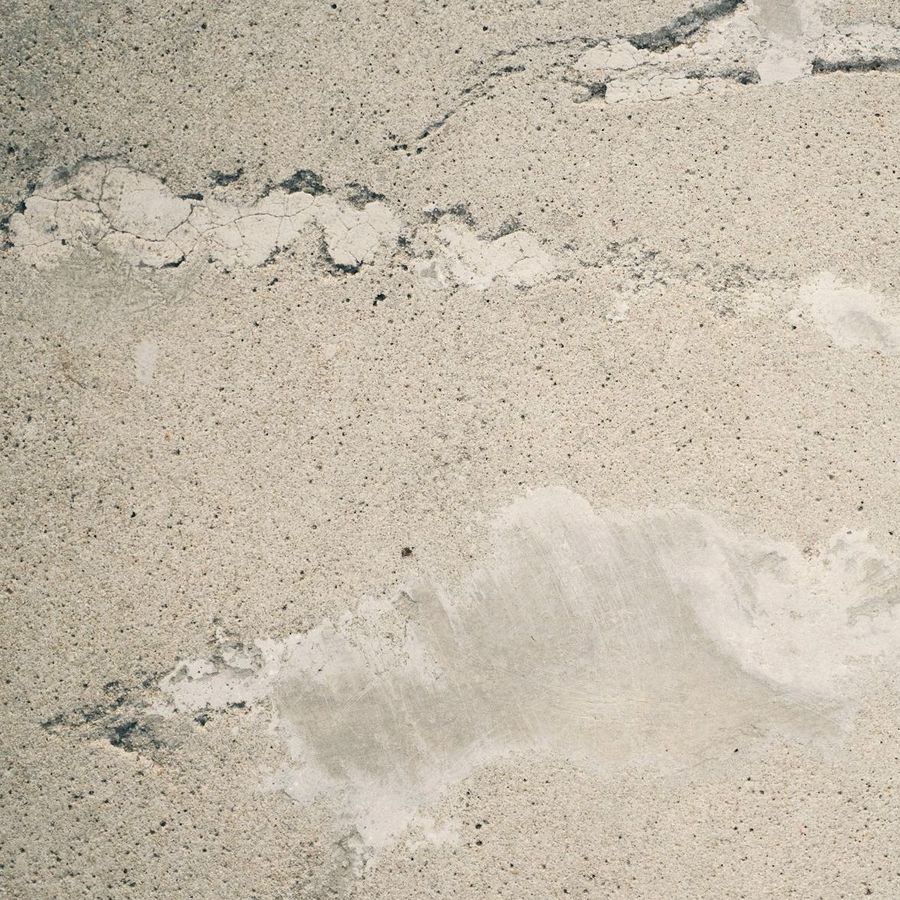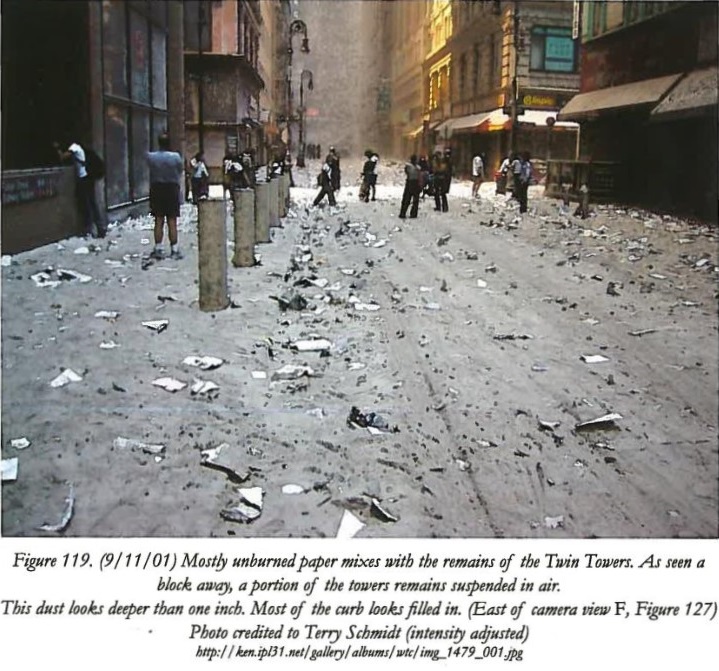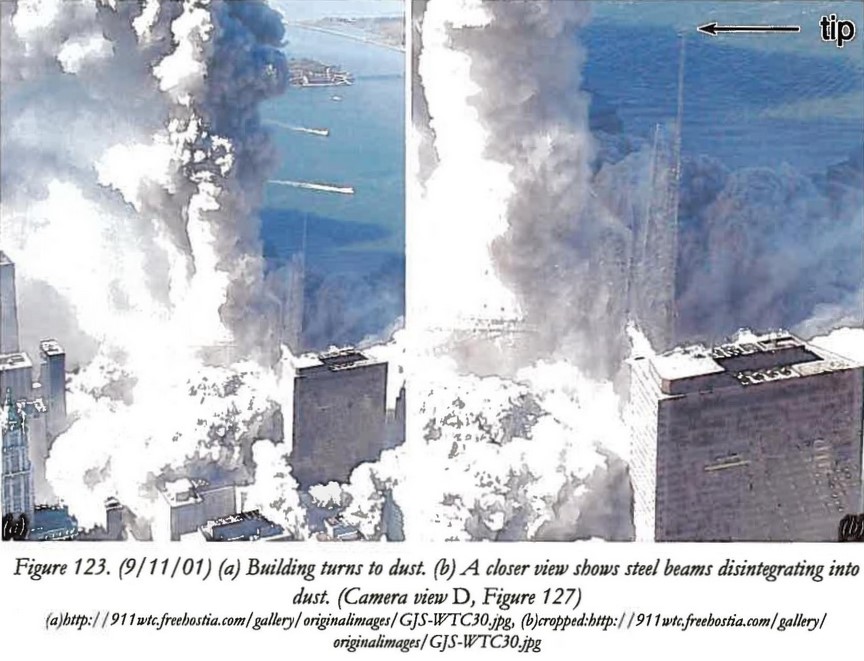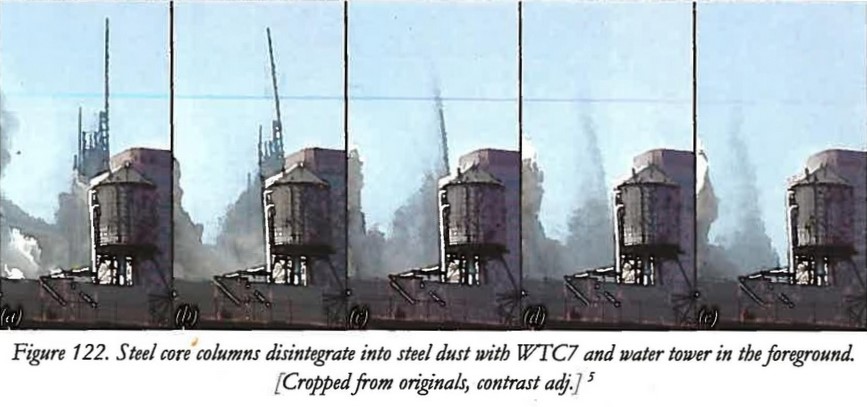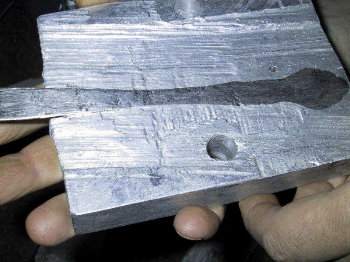“Nano-thermite” in the Dust?
Included in the “9/11 Truth Movement” is the argument that in further proof of the “controlled demolition” hypothesis, is the presence of super-fine, nano-sized particles of “thermitic material” found in the WTC dust, herein referencing the compound: thermite. As Judy Wood explains, thermite is used in the welding of metal and is not an explosive, however it has been used in military applications to ‘burn critical papers fast to protect secret documents’ or to permanently disable military weapons or equipment. Thermite canisters have been employed in military applications during World War II as a means to cause fire, with wooden buildings being most susceptible to such fires. [1]
Thermite is composed of aluminium powder and iron oxide, also known as “rust”. Both WTC1 and WTC2 were ‘steel structures with aluminium cladding. “Steel is a term used for iron to which between 0.02 to 1.7% carbon has been added.” Typical low-carbon steel…contains 99% iron. We know that a large portion of the towers was turned to dust…And iron dust in atmospheric conditions will immediately rust. So it is natural and to be expected that materials the buildings were made of would be found in the nano-dust of their remains. The surprising thing would be if this nano-dust from the buildings did not contain “thermitic material”.’
Importantly, Wood raises the idea of “proof of concept” as it relates to hypothesising the use of thermite as the means with which WTC1, 2 and all other buildings in the WTC complex were partially or fully destroyed. Wood argues, ‘no evidence that thermite, thermate, super thermite, or nano-enhanced thermite have ever been used to bring down major buildings in controlled demolition…Thermite has never been used to bring down skyscrapers. There is no proof of concept for the thermite hypothesis’. Additionally, she writes, ‘The buildings were turned to dust, and therefore the dust would be expected to contain traces of all materials that were in the buildings. Finding traces of chocolate, sugar, and nano-wheat (flour) in the dust would not prove that chocolate-chip cookies turned the buildings to dust. It would not prove these ingredients had been combined as chocolate chip cookies in the buildings nor that such cookies were capable of turning buildings to dust. The same is true for thermite’. Neither has thermite, ‘ever been used to completely pulverize buildings in controlled demolition…The mechanisms of cutting and pulverization are mutually exclusive… “Cutting requires action in one direction…while pulverization requires action in all directions”.’ [2]
Another further issue arises when ignition of thermite is considered, along with the fact that ‘it takes a long time for thermite to cut through thin steel, far longer than the 8 to 11 seconds, the reported time it took for the towers to “collapse”.’ Wood asks the obvious questions regarding placement of thermite in both buildings, ‘How would ignition have been accurately controlled in a building of this size? How many remote control radio frequencies would be required to do this? How many ignition devices would be needed to cut 236 outer columns and 47 core columns on each of the 110 floors in each of the two towers? An ignition device on each column on each floor would total 31,130 ignitions. None of this would cut floor trusses or pulverize the concrete floors or any of the WTC contents, much less steel beams’, as well as one very practical problem, ‘that workers would not notice the walls of their offices missing while the explosives were being placed’. [3]
A New Concept of ‘Dustification’
Chapter 8 of Wood’s book enters into the analysis of what she terms “dustification”, which is used to describe observational evidence of the WTC towers becoming ‘dust in mid-air’. This process has not been seen before, and is not the same as “pulverized”, although the term is used loosely in earlier parts of the book to describe what is seen. However, here, the true meaning of the word “pulverized” is examined, which ‘refers to pounding or crushing a material. Merriam-Webster defines pulverize: “to reduce (as by crushing, beating, or grinding) to very small particles.” The Twin Towers were not crushed or ground up; they turned to dust in mid-air. They were not vaporized, either. Vaporization refers to the conversion of a liquid or solid to the vapor state by the addition of latent heat…This was a new process and a new process needs a new word to represent it. We will call this dustification, saying that the buildings were dustified.’
One glaring question raised by Wood as seen in photographic evidence of the WTC complex shortly after or on the day of 9/11 was the substantial lack of debris or material, as would be expected from two skyscrapers used as office premises. ‘Where are the so-called “pancaked” concrete floors? Where is the office furniture? Where is the office machinery? Where are the filing cabinets? Where is the wallboard? Where are the bookcases? None of these were anywhere. Most of such material appears to have turned to dust…’ [4] Additionally, ‘not a single toilet fixture or even a recognizable portion of one was found anywhere in the buildings’ remains. The two towers alone in all likelihood contained something near the number of 3,000 toilet fixtures. Not a single recognizable trace of any of them was found’. [5] Strangely, what did survive, as seen in one example photo below, was large quantities of unburned paper, ‘Why is it only paper that survived and not office furniture and office equipment? . . .Is it a special kind of paper that does not burn well, or is it a special kind of “fire” that does not easily burn paper?’ [6]
These photographs included below, taken from Wood’s book, showcase evidence for the immense volumes of dust produced in the destruction of the towers.

Fusion of Dissimilar Materials
Here, we take a closer look at what remained after the destruction of the WTC, and what this evidence further leads us to.
The following image is of different types of U.S. coins, found in the WTC debris, each with different materials composition as well as very different melting and boiling points. For example, the melting point of Nickel is 1,453°C, Copper is 1,084.6°C and Zinc is 419.73°C, while the boiling point of Nickel is 2,913°C, Copper is 2,562°C and Zinc is 907°C. [7] Wood elaborates that the ‘U.S. penny is made of zinc (97.5%) with a copper plating (2.5%). The U.S. nickel is made of copper (75%) with a nickel outside (25%). . . a penny would have exploded if the temperature had been above 907°C, the boiling point of zinc. Even more importantly, all of the coins would have melted before the temperature rose high enough to melt iron.’ [8] And yet, here they are, fused into one mass and still maintaining their original integrity and shape, which would normally be impossible with exposure to high heat temperatures, since if ‘heat were the agent, one would expect that the zinc…would be completely driven off’. Essential implying that some other form of energy, other than kinetic or thermal energy, has caused these dissimilar materials to fuse.
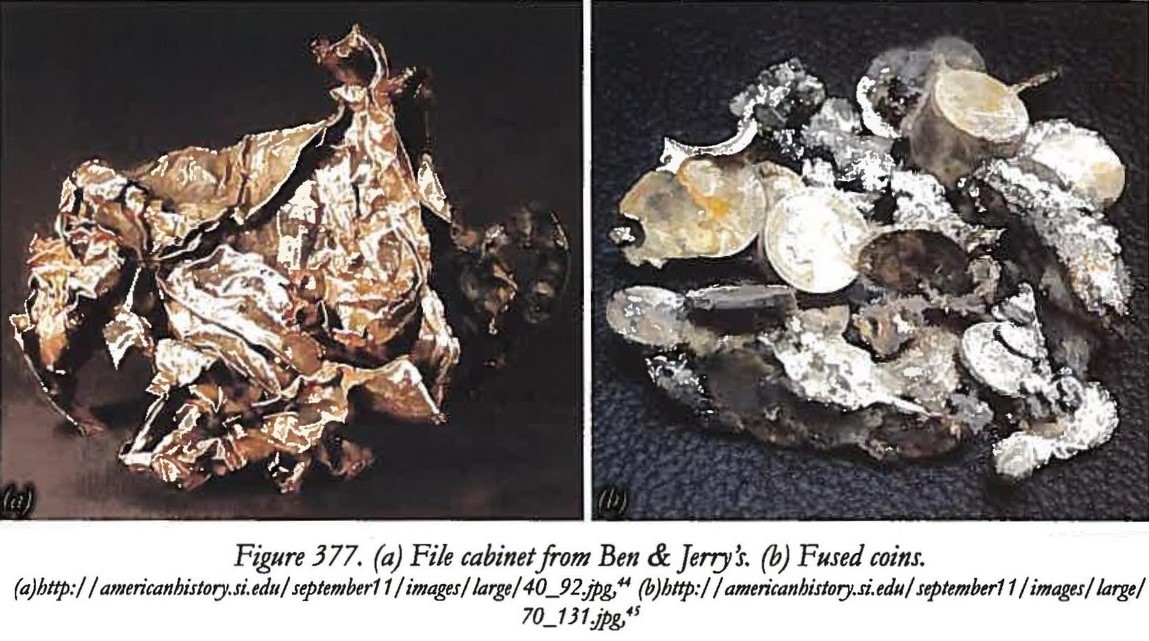
The following photograph is of what was termed the 9/11 “meteorite”, which contained ‘a stack of paper embedded in steel, concrete, and other material.’ [9] Image source
Image source
The Hutchison Effect
Wood references the work of John Hutchison, a ‘Canadian inventor and experimental scientist’, whose research has centred on “field effects” since 1979. These “field effects”, ‘are the result of interferometry, that is, the result of interfering several beams or fields of varying frequencies of electromagnetic energy in a target zone’, which can be likened to how ‘if you locate speakers a certain way, you may end up with dead zones where the sound is canceled or other zones where glass and china could be damaged. This is a type of destructive and constructive interference, where the interfering sound waves cancel or intensify the effects, respectively. Also, anyone familiar with the old rabbit-ears TV reception can probably remember the interference from jet airplanes. Jet airplanes interfered with the TV signal.’ Wood continues to explain, ‘The result of the interference created using the Hutchison Effect sets up a kind of “grid” or template within a target zone that causes materials in that zone to undergo extreme modification and, in some instances, disruption from within’. Some of the effects seen are:
‘1) Levitation of heavy objects,
2) Fusion of dissimilar materials, such as metal and wood. . .
3) Anomalous “melting” of metals without burning adjacent material,
4) Spontaneous fracturing of metals (sliding sideways),
5) Both temporary and permanent changing in crystalline structure and physical properties’. [10]
During weather events such as hurricanes and tornadoes, the phenomenon of “fusion of dissimilar materials” can be seen with “straw in tree trunks”, wood planks or sheets embedded in tree trunks, and even a garden hose found embedded in a tree trunk after a tornado. The common explanation is that sheer speed from high winds caused this to occur, however another force may be at work, which is also observed in the “Hutchison Effect”.
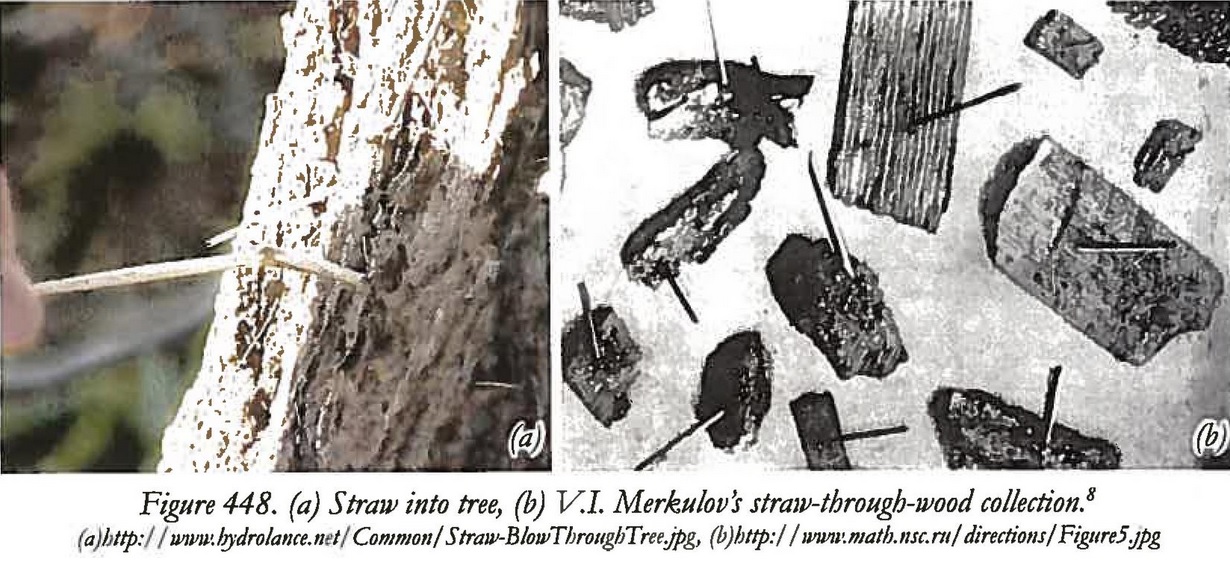
The following two images are from Hutchison’s experiments, showing ‘the fusion of entirely dissimilar materials, such as wood and aluminum’, as seen in the first photo below, and a knife fused in aluminum in the second photo.

Low Energy Nuclear Reactions / Cold Fusion
In the late 1980s, electrochemists Martin Fleischmann and Stanley Pons at the University of Utah, made the announcement of a discovery that would completely ‘violate cherished theories held for decades or hundreds of years’, in that in ‘near-room temperature’ conditions, they were able to instigate “electro-nuclear reactions” which involved ‘large excess energy production, but also tritium formation and the appearance of low levels of neutrons. Later, investigators began to observe heavier elements and strange isotopes that were not present when their experiments began’. (emphasis added) [11] Essentially to say that a new form of nuclear reaction had been discovered whereby atomic nuclear nature could be changed, under near-room temperature conditions (“low energy”) and produce by-products such as atomic elements not originally found in the experiment.
The phenomenon of nuclear transmutation is where an element, such as Nickel or Zinc, is converted into another completely different element, whereby the number of positively charged particles (protons) found in the nucleus of the atom, must be changed. Wood believes that such “electro-nuclear reactions” or “low energy nuclear reactions” may be more accurately termed “magnetic-electrogravitic-nuclear reactions”, with the resultant transmutation possibly being the ‘same mechanism that causes the Hutchison Effect’.
Tritium in the WTC
As mentioned previously, one of the outcomes of this “cold fusion” reaction is the production of a variation (isotope) of the hydrogen atom, known as tritium. The most common form of hydrogen contains one proton in it’s nucleus, however tritium contains one proton (hence it is still the same element called hydrogen) but with 2 negatively charged particles (neutrons) in it’s nucleus. [12] This “isotope”, or variation of hydrogen, has distinctly different properties than regular hydrogen, including being radioactive. What is interesting to note is that the radioactive energy produced by tritium is a ‘low energy beta that cannot penetrate the outer dead layer of human skin. Therefore, the main hazard associated with tritium is internal exposure from inhalation or ingestion’. [13] In samples taken from WTC6 and a WTC storm sewer, three days and ten days after 9/11, significant levels of tritium were detected, ‘about 50 times greater than background values’. Wood goes into further detail about tritium which you can read about here. The obvious glaring question remains, why would tritium be found at 50 times a normal background level, at the base of the rubble and storm sewer of the WTC after 9/11?
______________
There is such compelling and vast evidence available to read in Judy Wood’s book, as well as in the video presentation she gives, which is linked in the previous article. I would highly recommend those to anyone who would like a more in-depth analysis of the evidence that exists. As is mentioned in Wood’s book, ‘Remember, empirical evidence is the truth that theory must mimic, not the other way around’.
